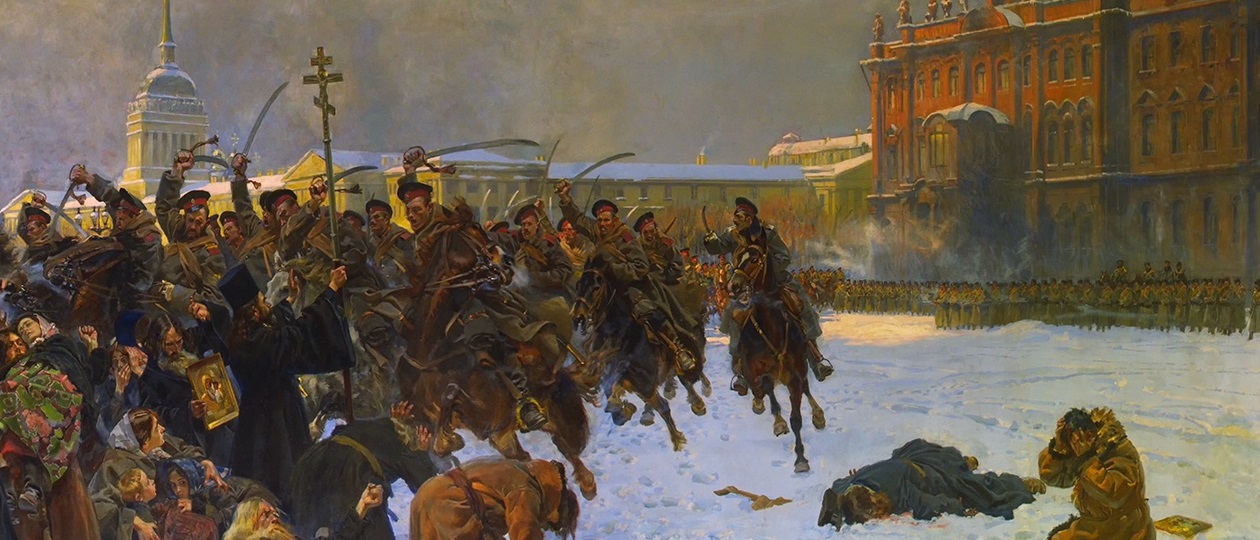
Terrorism was only one of several types of mass violence in the Revolution of 1905-1907. The other types included: the violence of mass protest movements, criminal violence, and government violence in suppressing the revolution.
The massiveness and varieties of violence in mass protest movements in the Russian Empire reached proportions not seen in Europe since the French Revolution of 1789-1804 and the European-wide revolutions of 1848-1849. As well, criminal violence often took on political dimensions just as it often did in the French Revolution.
The numerous conflicts along different lines demonstrated the disintegration of society. What saved the political-structure structure from total collapse was the fact that the bureaucracy, armed forces, and police stayed loyal to the government. This clearly distinguishes the Revolution of 1905-1907 from the Revolution of 1917-1922 when the Russian state and society virtually disintegrated in eight months between the February and October Revolutions.
Historians have tended to emphasize mass movements in the Revolution of 1905-1907 while ignoring terrorism and criminal violence. Soviet historians exaggerated the role of the working class under the leadership of the Bolshevik Party while Western historians have emphasized mass movements of workers and peasants.
If we look at all types of violence, then we can determine just how violence in the Revolution of 1905-1907 differed from violence in European revolutions especially between 1789-1849. Elements of Russian distinctiveness included the following elements.
- The Russian Revolution of 1905-1907 was the first European revolution with a strong terrorist component.
- The Russian Empire was the most multiethnic and multireligious country in Europe. Violence based on ethnic and religious lines often intersected with social factors.
- The revolution was the first European revolution in which political parties and movements participated.
- The violence of mass protest movements was practiced both by members of educated society and the common people.
Violence of Mass Protest Movements
Supporters of terrorism often stated that they used terrorism only in combination with mass movements of the people; this did not correspond to reality. Terrorism occurred along mass movements and only intersected with mass violence in certain regions of the Russian Empire.
Under the category of mass violent protest movements, we can include the movements of workers, peasants and other rural inhabitants, professional people, employees, and other urban strata, university and other post-secondary students, secondary school students, soldiers, sailors, ethnic and religious minorities along with the mass movements of empire-wide, ethnic minority, and Russian nationalist parties and movements spanning the political spectrum from right to left. Women often participated in mass movements as well as teenagers and even children.
The violence of these movements usually was expressed through uprisings, strikes, demonstrations, mutinies in the army and fleet, pogroms, peasant partisan activities in the forests, seizure and destruction of state and private property, inter-ethnic and inter-religious conflicts, for example, between Christian Armenians and Muslim Azerbaijanis, the overthrow of local authorities and the establishment of alternative authority right up to forming village republics, political and criminal murders of government and private people, frequent use of Lynch Law [самосуд] and other forms of popular vengeance. [1, c. 51]
The Revolution of 1905-1907 included conflicts not only between the government and different strata of the population, but also between different strata and within them. There were conflicts on political, social (estates and classes), ethnic, religious, regional, local, age, gender, and other lines.
The biggest mass protest movements took place in the border regions where ethnic, religious, and social factors often intersected. Huge outbreaks of violence took place in the western and southern provinces—Belarus, Ukraine, and Moldova—Poland, the Baltic region and in the Caucasus. Alongside these mass outbreaks of violence, there were many terrorist acts committed for political, social, ethnic, and religious reasons. [1, c. 51]
One type of mass violence—pogroms—has generated a huge amount of controversy among historians.
Pogroms
A pogrom [погром] is a mob or crowd attack aimed at the destruction of property and life. A particular group usually is the target of a pogrom. In the Russian historical context, pogroms are usually described as mob attacks against Jews with the implication that the government encouraged pogroms against Jews as a <<punishment>> for Jews or arguing that pogroms were a display of the people’s anger against the mass participation of Jews in revolutionary and opposition movements.
Dictionary definitions of pogroms tend to emphasize the specific nature of pogroms, especially in the Revolution of 1905-1907. One Russian dictionary edited by S. I. Ozhegov defined a pogrom as <<a chauvinistic outbreak against any national or other group of the population accompanied by robbery and murder>> or <complete disorder, destruction>>. [2]
Another Russian dictionary edited by A. P. Evgen’eva gave this definition of a pogrom–<< a reactionary-chauvinist outbreak against any national group of the population, accompanied by robbery of property and murders. Ruin, devastation, destruction.>> [3]
The Oxford Dictionary of the English language describes a pogrom as <<an organized slaughter in Russia, Poland, and several other Eastern European countries in the late 19th and early 20th centuries directed at the extermination of a group or class of people. A slaughter of Jews. An organized, officially permitted, attack on any community or group.>> [4]
Definitions tend to agree that a pogrom is usually an attack against an ethnic or religious group, particularly Jews. Furthermore, historians often insist that the tsarist government deliberately encouraged pogroms and took little measures to stop them.
The biggest wave of pogroms in the Revolution of 1905-1907 took place in the Jewish Pale of Settlement—in Ukraine, Belarus, Moldova—in two weeks after the proclamation of the Manifesto of October 17 granting political freedom and a State Duma. According to the calculations of Russian historian S. A. Stepanov, there were 360 pogroms with 1,622 people killed, including 711 Jews, and 3,544 people wounded, including 1,207 Jews. [5, cc. 88-90] American historian Abraham Ascher suggested that 900 people were killed in the October pogroms and up to 8,000 injured. [6, p. 255]
However, the traditional interpretations of pogroms need a huge degree of correction. Pogromists, especially in areas outside the Jewish Pale of Settlement, attacked students, professional people, and socialists.
Historians have usually accused the far-right Black Hundreds, especially the mass Union of the Russian People, with conducting pogroms. However, Stepanov correctly noted <<The Black Hundreds have earned a pathetic reputation for the pogroms of 1905. For the sake of justice, it is necessary to note that the outbreaks of mass violence happened before the formation of the Union of the Russian People although many of its future members actively participated in pogroms. >> [7] The Union of the Russian People was formed in November 1905.
As will be explored in future articles, the Black Hundreds have traditionally received a negative image and are often regarded as proto-Fascists or proto-Nazis. As Bertram Wolfe, an American political scientist and former Communist, wrote << <<Under the banner of Holy Russia was gathered a most unholy and variegated band: the backward, the degenerate, the brutalized, the bewildered, the enraged, the entrenched, the ruined: officers, landowners and gilded youth, demobilized old soldiers and personal serving men to whom loyalty to the master was the sum of all loyalties, criminals whose police record made them amenable to any instructions, ruined artisans and shopkeepers who were persuaded that the strikes and the eight-hour day were the cause of all their woes, hungry, degraded slum proletarians from the human scrapheap of the great cities, the more illiterate and credulous among the workingmen and peasantry.>> [8, p. 327]
The complex ethnic, religious, and social structure of the population of the western provinces, especially in Right-Bank Ukraine (Kiev, Podoliya and Volyn provinces) make it a powder keg for pogroms and most Black Hundreds in Russia came from those provinces. Orthodox Ukrainian and Belarusian peasants made up the majority of the population, while Jews predominated in trade and handicrafts and Polish Roman Catholic nobles were the biggest landowners. The October pogroms were a form of economic protest against the dominance of Jews in the economy. Black Hundreds peasants also demanded the confiscation of lands belonging to Polish Roman Catholic nobles. [5, cc. 435, 414, 348]
The participation of workers in pogroms has embarrassed historians used to seeing the working class as a Russian equivalent of a disciplined European-style proletariat. Historian O. V. Budnitskii argued that many workers were disillusioned by the October general strike and the October Manifesto because their participation in the strike and other upheavals during 1905 did not lead to improvement of their material position. Instead, many workers suspected that the only people to benefit from the general strike, manifesto, and revolutionary turmoil were members of the intelligentsia—who included many Jews. This was the opinion expressed by many Europeans who believed that the only beneficiaries of industrialization and liberalism were the Jews. Thus, workers vented their rage and frustration through pogroms against Jews, students, and members of the intelligentsia. [6, c. 58]
While it is true that local government officials often did little to prevent pogroms or delayed restoring order, one cannot accuse the government of deliberately instigating pogroms. A pogrom was a violation of order even if it was directed against Jews or other groups hated by the government. Many Black Hundreds and Russian nationalists realized that pogroms could have far-reaching consequences. As the Russian nationalist V. V. Shul’gin noted <<a Jewish pogrom is the beginning of anarchy all around. It is the beginning of the so-called ‘black rebellion’. They will begin with the Jews, but they will most certainly end by knocking out all there is of culture and by smashing that by which with such very great labour we have succeeded in setting up.>> [10, p. 405]
Pogroms were not limited to the far right. Any mass riot especially by workers, peasants, and other members of the lower classes could turn into a pogrom with destruction of property and life. This interpretation has been distasteful to Soviet and Western historians who present workers as a disciplined European-style proletariat. Nor was killing people because of their ethnicity or religion unique to the Black Hundred movements. Ethnic-based violence. spanned the political spectrum in Russia. Members of Polish, Ukrainian, Belarusian, Jewish, Georgian, Armenian, Estonian, Latvian, and Lithuanian left-wing terrorist organizations killed people because of their ethnicity or religion and this was often combined with social and political factors.
The issue of pogroms is highly relevant for today because there are many mass violent movements such as the Yellow Vests in France which are not affiliated with political parties and who often regard the parties as part of the hated establishment that must be destroyed.
Criminal Violence
Criminal violence exploded during the Revolution of 1905-1907 because of the breakdown of order and the fact that local administration stopped functioning in many parts of the empire.
Many people took the law into their own hands. Landowners and business owners often hired bodyguards for their personal security and private militias to protect their property against attacks by workers and peasants. Homeowners organized vigilance and self-defense committees. Jews and their sympathizers organized self-defense units during pogroms. Peasants often practiced Lynch Law against criminals especially in places where they had overthrown the local authorities and established alternative authority. [6, pp. 128-133].
At the start of the 20th century, police annually investigated 17,000 murders. In 1904-1908, police investigated 30,000 murders each year. [11, p. 34] Criminal violence often took on political dimensions. Police often could not distinguish between political and criminal motives in murder cases. Often <<economic terrorism>> intersected with criminal banditry during <<revolutionary expropriations>>–armed robberies of banks, other financial institutions, government and private offices, and private individuals to raise money for the revolutionary movement. Many criminals, when arrested, often told the police that they were anarchists or revolutionaries in hopes of obtaining the privileged status of political criminals.
The violence of terrorists, mass protest movements, and criminals in the Revolution of 1905-1907 made this period the biggest outbreak of violence since the French Revolution and European revolutions of 1848-1849.
The next chapters will examine how the Russian government tried to restore order and put an end to violence from below.
Terrorism and Other Types of Mass Violence in the Russian Revolution of 1905-1907: Part 5
Citations
- Рокки, Т. Российская революция 1905-1917 гг. как первая гражданская война в Европе в ХХ веке. (Rocchi, T. The Russian Revolution of 1905-1907 as the first civil war in Europe in the 20th century). История. Историки. Источники. 2022, № 4, сс. 46-55. https://s.esrae.ru/history2014/pdf/2022/4/362.pdf
- Погром. Толковый онлайн-словарь русского языка Ожегова С. И. (Pogrom. Explanatory online dictionary of the Russian Language by S. I. Ozhegov. (Режим доступа: lexicography.online/explanatory/ozhegov/
- Значение слова погром в толковом онлайн-словаре А.П. Евгеньевой (Meaning of the word pogrom in the explanatory dictionary of the Russian language by A. P. Evgen’eva) Значение слова погром в толковом онлайн-словаре А.П. Евгеньевой lexicography.online/explanatory
- Oxford English Dictionary. Third Edition. 2011. Electronic Version.





